- 徳川家康が、自身の9男であり尾張徳川家の初代である徳川義直に遺した遺産「駿府御分物」を中核に、尾張徳川家歴代当主や夫人たちの遺愛品が加わり、さらに明治時代以降の収集品や寄贈品も加えて、1万件あまりの貴重な大名道具・美術品を所蔵しています。
-
徳川美術館の所蔵品には国宝9件・重要文化財59件・重要美術品50件が含まれます。なかでも、12世紀前半に製作されたと考えられ、『源氏物語』を絵画化した作品として現存最古の国宝「源氏物語絵巻」、また、3代将軍徳川家光の長女千代姫が尾張徳川家2代徳川光友に嫁いだ際の婚礼調度類である漆工品の最高峰、国宝「初音の調度」は、コレクションの華というべき名高い逸品です。
また、武家にとって最も重要な品だった刀剣のコレクションにも、国宝・重要文化財が多数含まれます。その他、茶道具、能道具、雛人形など、種類の豊富さ、質の高さ、保存状態の良さにおいて世界に誇るコレクションを形成しています。 - 毎年11月中旬から下旬にかけて、全15巻の絵巻の中から1~2巻を選んで特別公開いたします。また、徳川美術館の周年となる西暦末尾が5の年には全巻を一挙公開しています。次回の全巻一挙公開は2025年の90周年を予定しています。
- レプリカではありません。徳川美術館の所蔵品はその大多数が、尾張徳川家の居城である名古屋城や江戸屋敷の中で家宝として大切にされてきました。そのため今日まできわめて良い状態で保存されていることが大きな特徴です。
- 徳川美術館の刀剣は現在主流となっている化粧研ぎを行っていないため、一般的に目にする刀剣と比較して刃文の見え方が異なる場合があります。これは江戸時代に研がれた状態をそのまま伝えることを目的として手入れされているためです。明治時代以降の混乱や戦時の空襲も生き延びて、一貫した保存方針のもと今日に伝えられた貴重な遺産です。
- 徳川美術館の本館は建物の外観デザインを公募して昭和7年(1932)に着工、昭和10年春に完成しました。同年秋に開館すると、近代的設備を備えた画期的美術館としてヨーロッパの建築界にも紹介されました。当時の展示棟と収蔵庫(現在の本館展示室および南収蔵庫)は、城郭を想わせるような帝冠様式の建築で、昭和初期のわが国の美術館建築を代表する建造物として国の登録有形文化財に登録されています。
- 昭和60年(1985)に美術館開館50周年を記念して新館の建築が計画され、お寄せいただいた多くの寄附金をもとに、昭和62年に新館が完成しました。白壁に緑の屋根を擁する新館の外観は、名古屋城をモチーフとしています。名古屋城の枡形虎口(ますがたこぐち)に、鉄炮を打ったり矢を射たりする狭間(さま)をイメージした装飾を備える玄関ホールを進むと、名古屋城の不明門を模した展示室入り口が出迎えます。
- 茶室(餘芳軒・山ノ茶屋)は非公開です。茶室を使用する徳川茶会や当館主催のイベントにご参加のお客様は見学・ご利用いただけます。
- 徳川美術館では、館内一部施設および茶室の貸出を行っております。詳細は団体用プログラムページをご覧ください。
- スマートフォン、タブレット端末、コンパクトカメラでの写真撮影や情報検索が可能です。ただし、他のお客様への迷惑となる行為や作品の保護・安全を損ねる機器の使用・撮影はご遠慮ください。なお、一部撮影不可の作品がございます。詳しくは展示室入り口の掲示板等にてご確認ください。
- 他のお客様の迷惑にならない範囲でメモやスケッチをすることは可能です。ただしボールペンやシャープペンシルの使用はご遠慮いただいております。鉛筆のみご利用いただけます。
- 館内全エリアにて無料Wi-Fiのご利用が可能です。
- チケットのご購入およびミュージアムショップにてクレジットカード・ICカード・QRコードでの決済がご利用いただけます。
- オンラインチケットにて購入いただけます。こちらのサイトにてご確認ください。
- 美術館チケット売場または徳川園チケット売場にてセット券を販売しております。
- 徳川美術館と名古屋城のセット券は販売しておりません。
- 平均60分~90分とご案内しています。また、展示替え期間中(名品コレクション展示室のみ)の場合は約30~40分とご案内しています。ゆっくり解説を読みながら鑑賞するような場合は、2~3時間を予定していただくことをおすすめします。
- 当日の再入館は可能です。再入館をご希望の方は、入館券裏面に日付印を押しますので、インフォメーションにお申し出ください。
- スムーズに館内へご入館いただくため、可能な限りご予約をお願いします。ご予約の際はこちらのご予約フォームをご利用ください。
- 利用料100円で、使用後に硬貨が返却されるコインロッカーがございます。数種の大きさをご用意しており、キャリーケース等を預けることもできます。コインロッカーに入らない荷物がある場合には、ミュージアムショップでのお預かりも可能です。ご希望のお客様はミュージアムショップへお申し出ください。
- 館内はバリアフリーになっていますので、車椅子やベビーカーでお回りいただけます。車椅子対応のお手洗いも設置しております。また、貸出用の車椅子及びベビーカー(無料)もご用意しております。 ご希望の際はチケットご購入時に係へお伝えください。
- ペットとの入館はご遠慮いただいております。盲導犬、聴導犬、介助犬の同伴は可能です。
- 徳川美術館では、敷地内に「日本料理宝善亭」がございます。当日でもご利用は可能ですが、団体のお客様もご利用されるため満席の場合がございます。 事前にご予約のうえご利用ください。 また館内には軽食をご提供するミュージアムカフェがございます。28席ご用意しておりますので、お食事やご休憩にご利用ください。
- お持ち込みによる館内でのお食事はご遠慮いただいております。「日本料理宝善亭」および館内の喫茶室をご利用ください。
- ございません。全館禁煙となっております。
- 館内西側のロビーに自動販売機をご用意しております。 なお、展示室内および玄関ホールでの飲食はご遠慮いただいております。お飲み物をお召し上がりの際は、西側または東側のロビーをご利用ください。
- ミュージアムショップやザ・ミュージアムカフェのみの利用でも入館料が必要となります。
- 徳川美術館では、古美術品の取り扱い方法、保存方法などについてのご相談に応じる「古美術品保存相談」を行っています。 ご希望の方は、まずはお問い合わせフォームからご連絡ください。 ただし、真贋や評価額に関するお問い合わせには応じかねます。
FAQ
よくあるご質問
This site is translated using the automatic translation service "DeepL".
FAQ
